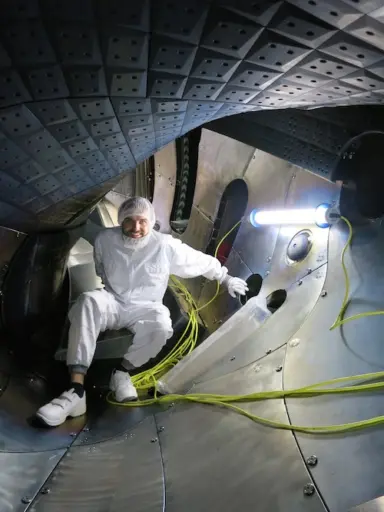For years University of Wisconsin-Madison plasma physicists in the College of Engineering have been key collaborators in fusion research at the Wendelstein 7-X, the largest and most advanced stellarator experiment in the world.
Now, UW-Madison and the Max Planck Institute for Plasma Physics, which houses the Wendelstein 7-X in Greifswald, Germany, are taking their collaboration to a new level: They’re embarking on a joint research project called the Helmholtz International Lab for Optimized Advanced Divertors in Stellarators (HILOADS).
“This is a very exciting step for us as it forms a formally defined alliance between the fusion efforts in the field of stellarator and divertor research at UW-Madison and the flagship experiment Wendelstein 7-X,” says nuclear engineering and engineering physics Professor Oliver Schmitz, who led the effort at UW-Madison to establish the international lab. “It provides a framework for strengthening the research endeavors and coordination on both sides in a highly synergistic way, which will enable us to drive innovation and make major breakthroughs in this field.”
 From left-right: Professor Oliver Schmitz and grad students Erik Flom, Kelly Garcia and Aysia Demby. The students’ research projects focus on the Wendelstein 7-X experiment. Photo: Sarah Page.
From left-right: Professor Oliver Schmitz and grad students Erik Flom, Kelly Garcia and Aysia Demby. The students’ research projects focus on the Wendelstein 7-X experiment. Photo: Sarah Page.
Forschungszentrum Jülich, one of the largest interdisciplinary research centers in Europe, and Auburn University are also participating in the international lab, which is financially supported by the Helmholtz Association of German Research Centers. On the U.S. side, the funding for the HSX experiment at UW-Madison as well as for the international collaboration at Wendelstein 7-X is provided by the Office of Fusion Energy Sciences within the U.S. Department of Energy’s Office of Science.
The goal of the international lab is to design a new divertor concept that will improve the performance of next-generation stellarators. This work could bring humanity a step closer toward realizing fusion, the process that powers our sun, as a commercially viable source of environmentally friendly energy.
Stellarator-type fusion devices use magnetic coils to create three-dimensional magnetic fields that confine the high-temperature plasma inside a vacuum chamber. The fusion process produces helium ash, which needs to be removed to keep the plasma clean for continuous operation.
That’s where the divertor comes in.
The divertor is a reactor component located at the outer edge of the plasma that essentially serves as an exhaust system. Helium ash accumulates in the divertor and gets pumped out. At the same time, the divertor also needs to handle associated heat fluxes.
“The divertor plays a critical role in taming the interaction between the hot plasma and the walls by handling the particle and heat exhaust,” Schmitz says.
How well the divertor can perform this important task depends on the structure of the magnetic field and the choice of material. Given the complexity of the plasma physics and materials challenges, designing a new divertor is a highly demanding undertaking that requires extensive experimental and theoretical investigations.
 Thierry Kremeyer (PhDNEEP ’19), a postdoctoral scholar in Schmitz’s group, in the Wendelstein 7-X stellarator. Submitted photo.
Thierry Kremeyer (PhDNEEP ’19), a postdoctoral scholar in Schmitz’s group, in the Wendelstein 7-X stellarator. Submitted photo.
“How a new divertor is designed, and how it can be operated for a stellarator in a steady state fashion, is a field of research that has just been started seriously,” Schmitz says.
To explore this new territory, Schmitz and his partners in the international lab will conduct coordinated experiments at three stellarators—Wendelstein 7-X, the Helically Symmetric eXperiment, or HSX, which is housed in the UW-Madison Department of Electrical and Computer Engineering, and the CTH (Compact Toroidal Hybrid) device at Auburn University. And the researchers will further develop and validate state-of-the-art numerical tools to analyze those experiments.
The researchers will also use two linear plasma systems, one in Schmitz’s lab at UW-Madison and one in Jülich, to investigate materials and wall conditioning.
In addition to Schmitz’s expertise in plasma edge and divertor physics, several other faculty members from the UW-Madison College of Engineering are contributing to the effort. Professor Chris Hegna and Assistant Professor Benedikt Geiger, both from the engineering physics department, will provide expertise in optimizing turbulent transport and impurity handling in stellarator plasmas. And Electrical and Computer Engineering Professor David Anderson, who founded and directs HSX, will contribute his extensive knowledge of modular optimized stellarators.
“We’re trying to tackle a big integration challenge with this project,” Schmitz says. “We want to optimize the plasma core to reduce turbulence and then find a way to fit an appropriately shaped and designed divertor on the device so that the plasma and the exhaust system will play nicely together.”
Schmitz says the research from this international partnership will lay the groundwork for a possible new medium-sized stellarator experiment at UW-Madison. Such an experiment would be needed to test the new divertor design integrated with improved plasma performance, he says.
“With this research, we want to figure out what needs to go into a new stellarator experiment to answer key scientific questions and allow us to make major breakthroughs in this area, not just incremental improvements,” Schmitz says.
In addition to the research, Schmitz is also very excited about new educational and training opportunities available through the international lab that will be instrumental in drawing top students into the field of fusion research. For example, the lab includes an international graduate school component that would give students in Europe the opportunity to earn a master’s degree in fusion science at UW-Madison. Schmitz says this allows students to gain stellarator research experience early on in their career, providing a training path that usually is not offered at the master’s program level.
“So this means that HILOADS will combine student portfolios from UW-Madison and German partners, which makes our graduate program even more international and well-equipped for the research challenges in this international lab,” Schmitz says.